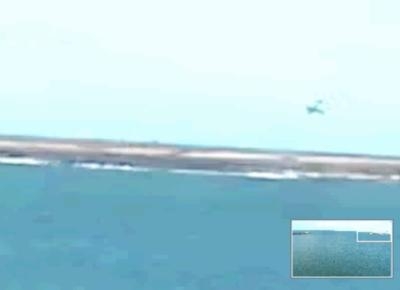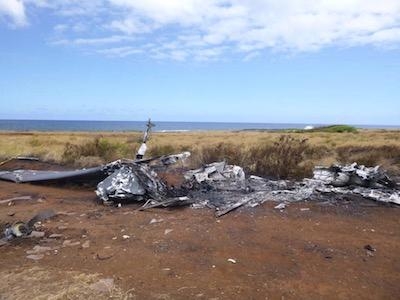Cessna 182H Went Down In 2016 Resulting In Five Fatal Injuries
The NTSB has released its factual report from an accident which occurred May 23, 2016 involving a Cessna 182H carrying four skydivers in Hawaii. All five people on board the aircraft were fatally injured in the accident.

According to the report, the aircraft impacted terrain following a partial loss of engine power shortly after departure from Port Allen Airport (PAK), Hanapepe, Hawaii. The pilot and four passenger-skydivers were fatally injured. The airplane was registered to and operated by D & J Air Adventures, Inc., under the provisions of 14 Code of Federal Regulations Part 91 as a skydiving flight. Visual meteorological conditions prevailed, and no flight plan was filed.
Numerous witnesses reported that the airplane departed runway 9, it began to roll to the right while rapidly losing altitude. Two witnesses stated that it seemed the engine had stopped producing power. The airplane completed about a 360° rotation and impacted terrain in a nose-low attitude.
A video taken from a security camera located about 0.8 mile northeast of PAK showed the airplane in a climb, followed by a sudden right roll, and a rapid descent toward the terrain in a nose-down attitude. The airplane came to rest at the edge of a dirt road in a grassy area just outside the airport perimeter fence, and a postimpact fire ensued.
The pilot held a commercial pilot certificate with airplane single-engine land and multi-engine land ratings and an Australian private pilot certificate with an airplane single-engine land rating. A first-class airman medical certificate was issued to the pilot on February 24, 2016, with no limitations. During his last medical exam, the pilot reported flight experience that included 321 total flight hours and 53.2 hours in last 6 months. A representative of the pilot's family provided a copy of the pilot's logbook, and the most recent entry in the logbook was for a flight of 1.1 hours on March 5, 2016.
The four-seat, single-engine, high-wing, fixed landing gear airplane, serial number 18256107, was manufactured in 1965. In September 1972, the airplane was configured for parachute operations, which included removal of the front right seat and the rear seat. The modifications also included the removal of original cabin seats and installation of floor level seat belt brackets to accommodate four occupants in addition to the pilot. The airplane was powered by a Continental Motors O-470-R engine, serial number 203374-70R, rated at 230 horsepower. The airplane was also equipped with a McCauley two-bladed, constant-speed propeller. A review of maintenance records showed that the engine was installed on November 12, 2013, at a total airframe time of 10,043.7 hours. The most recent annual inspection was completed on October 13, 2015, at a total engine time of 8,121.3 hours and a total airframe time of 10,783.6 hours. The most recent maintenance activity recorded in the logbooks was a nose landing gear
inspection completed on May 19, 2016, at a tachometer time of 8,353.5 hours (925 hours since engine overhaul).
Weight and balance values were calculated for the accident takeoff using the airplane's weight and balance documentation dated February 23, 2015. The input values included a presumed fuel quantity of 20 gallons (120 pounds) and an owner-provided total weight of pilot, passengers, and parachutes of 981 pounds. The takeoff gross weight was calculated to be 2,810.5 pounds with a center of gravity (CG) of 41.2 inches. Maximum allowable gross weight was 2,800 pounds, and the allowable CG range for that weight was 38.4 to 47.4 inches.

According to the owner, the airplane was refueled on May 23, 2016, with fuel from a nearby gas station. A supplemental type certificate (STC) issued for the airplane allowed for the use of automotive gasoline; the STC did not approve the use of fuel containing ethanol. Both ethanol and ethanol-free gasolines are sold in the state of Hawaii. Hawaii does not require a placard on pumps for gasolines that contain less than 1% ethanol. According to a European Aviation Safety Agency (EASA) report titled "Safety Implication of Biofuels in Aviation," a fuel system that uses ethanol-mixed gasolines has a higher probability to develop vapor lock, carburetor icing, or experience a water-induced phase separation; these conditions can potentially disrupt engine operation.
The wreckage was located next to a dirt service road, about 250 ft from the departure end of runway 9, and at an elevation of about 90 ft mean sea level (msl).
The wreckage debris path was oriented on an approximate heading of 060° magnetic and was about 24 ft in length. The first identified point of impact was a crater in the dirt road that contained the propeller hub with both blades attached; small pieces of airframe and other debris surrounded the disrupted dirt. The rest of the airplane came to rest about 7.5 ft from the propeller. The engine was displaced aft into the firewall, and both the engine and firewall were crushed aft into the cabin area by impact forces.
The cockpit, fuselage, left wing, and forward portion of the empennage were consumed by the postcrash fire. The engine and the right wing exhibited impact and postimpact fire damage. The right wing separated from the fuselage and was displaced forward next to the cockpit area. The right horizontal stabilizer and the elevator remained attached to the empennage, and they exhibited impact and postcrash fire damage. The composite left- and right-wing tips were respectively located left and right of the main wreckage about 71 ft apart.
During the postaccident examination, about 12 gallons of fuel were drained from the right wing. The recovered fuel was clear and colorless, and a water paste test did not indicate any water contamination. No test was performed to determine whether there was ethanol in the fuel.
The wreckage was recovered to a secure location for further examination.
(Images included in NTSB Accident Docket)
 Aero-News: Quote of the Day (10.24.25)
Aero-News: Quote of the Day (10.24.25) ANN's Daily Aero-Linx (10.24.25)
ANN's Daily Aero-Linx (10.24.25) NTSB Final Report: Cirrus SR22
NTSB Final Report: Cirrus SR22 Airborne-Flight Training 10.23.25: PanAm Back?, Spirit Cuts, Affordable Expo
Airborne-Flight Training 10.23.25: PanAm Back?, Spirit Cuts, Affordable Expo Airborne 10.22.25: Rez Takes Plane, DJI v US Drone Ban, HK 747 Cargo Accident
Airborne 10.22.25: Rez Takes Plane, DJI v US Drone Ban, HK 747 Cargo Accident




